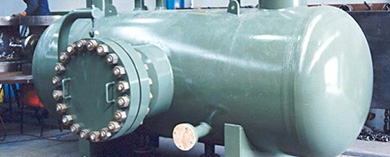
- (03) 5909 8218
- enquiry@fusionweld.com.au
A Look into Pressure Vessels and How They Are Made
February 17, 2014

In the past, old boilers and pressure vessels were so prone to explosions, and true to form, they caused considerable losses including damage to property and loss of life. The risks in handling pressure vessels led to the formation of various engineering societies with the goal of establishing standard safety rules in the construction and use of pressure vessels and boilers.
Steel has always been the first choice when it comes to the manufacture of boilers and pressure vessels, thanks to the material’s high tensile strength. Pressure vessels have the ability to store gasses and hot liquids safely without causing any damage to the container.
Pressure vessels, especially the ones with industry applications, are designed to be leak-tight pressure containers. They are usually cylindrical in shape, with various head patterns and configurations. While many are made from steel sheets, some are use carbon as pressure vessel material. Both are assembled by welding. Certain pressure vessel boards regularly meet to consider the latest proposed revisions on the way pressure containers are supposed to be made. There are existing codes and rules that need to be followed to ensure the safety and dependability of pressure vessels being used by the public.
Large industrial boilers and pressure vessels should undergo regular inspection to guarantee the safety of the people near them. Companies who use pressure vessels hire engineering experts to inspect and evaluate the condition of their tanks.
Metal pressure vessels are used as gas nuclear reactors, industrial boilers, and petrochemical factories. Manufacturers of pressure vessels always make sure that their products meet the international safety standards considering the fact that they will act as storage to hot liquids and gases. The high malleable feature of steel makes it ideal for these types of industrial applications. Pressure vessels have the ability to withstand hot liquids and gasses.
There are two major types of pressure vessels – simple vessels and complex vessels. The former is made minus sections and complex support systems. Pressure vessels carrying nitrogen are samples of this type. Complex vessels, on the other hand, are those that were built with sections and support systems.
When designing pressure vessels, a lot of factors are considered including:
- Internal and external dynamic and static forces
- The various kinds of temperatures including ambient and operational
- The weight of the vessel and its contents
- Various types of stresses such as localised stress, residual stress, and thermal stress and their areas of concentrations
- Container reaction from attachments, piping, et cetera
- Material fatigue
- Metal corrosion
These containers are usually coated with ceramics, other forms of metal, and polymers. The lining provides protection on the structural integrity of the pressure vessel and prevents leaking.
Most pressure vessels are designed as sphere-shaped tanks because they are more stable in that shape. The walls of a pressure vessel tend to bow because f the pressure and shaping the container like a sphere takes advantage of this innate tendency.
Contact Details
Fusion - Weld Engineering Pty Ltd
ABN 98 068 987619
1865 Frankston Flinders Road,
Hastings, VIC 3915
Ph: (03) 5909 8218
Optimized by NetwizardSEO.com.au
Recent Posts
- Compressed Hydrogen Storage Vessels: Material Selection, Design & Australian Standards
- Welding QA/QC in Oil & Gas Pressure Vessel Fabrication – Ensuring Code Compliance
- AS1210 vs ASME VIII Pressure Vessel Code: Key Differences for Australian Projects
- Mitigating Hydrogen-Induced Cracking in Pressure Vessels: Engineering and Material Strategies
- Storage Tank Solutions Australia: Field-Erected, Prefabricated & Self-Bunded Explained
- Reducing Environmental Risks: Self-Bunded Tanks in Australian Oil & Gas Operations
- Precision in Production: How Pressure Vessels Are Manufactured for Industrial Safety
- Shell & Tube Heat Exchangers: Improve Thermal Control & Energy Recovery in Petrochemical & Pharmaceutical Plants
- In-Service Inspection for Compressed Air Receivers for Power Plant Shutdown Prevention
- Power Plant Pipe Spooling Fabrication – Get Rapid, Code-Compliant Spools Ready for Installation
- Field Erected Tanks: Safe, Reliable On-Site Fuel Storage Solutions in Australia
- Custom Pressure Vessel Fabrication for Flammable Gases
Posts 2025
- Compressed Hydrogen Storage Vessels: Material Selection, Design & Australian Standards
- Welding QA/QC in Oil & Gas Pressure Vessel Fabrication – Ensuring Code Compliance
- View all articles…
Posts 2024
- Large Process Vessels: Optimising the Design for Maximum Efficiency [2025]
- Pressure Equipment Management System Installation: Detect Equipment Faults Early
- View all articles…
Posts 2023
- Pressure Piping System Inspection: A Gift of Safety for the Holidays
- Deaerator Inspections by Fusion-Weld Engineering and How They Reduce System Downtime
- View all articles…
Posts 2022
- How Fusion Weld Keeps Up With AS-NZS ISO 9001:2008 Standard
- Boiler Equipment Safety Inspection During the Summer Season
- View all articles…
Posts 2021
- Avoid These Factors and Practices that Contribute to Sealing Damage in Pressure Vessels
- Do's And Don'ts Of Industrial Boiler Inspection And Maintenance From Fusion-Weld
- View all articles…
Posts 2020
- What are the Risks and Hazards Involved in Pressure Vessel Equipment?
- How to Know if Your Pressure Equipment Needs Repair or Replacement?
- View all articles…
Posts 2019
- Factors that Contribute to Pressure Vessel Failure
- Pressure Vessel Regulations in Australia: What are the Mandatory Requirements?
- View all articles…
Posts 2018
- Pros and Cons of Spherical vs. Cylindrical Pressure Vessels
- What are the Different Hazard Levels in Pressure Vessels?
- View all articles…
Posts 2017
- Transportable Pressure Vessels: The Importance of Inspection and Safety Checks
- Fracture Mechanics and Stress Analysis of Cracks in Pressure Vessels
- View all articles…
Posts 2016
Posts 2015
- What Are Deaerators & Feedwater Vessels?
- Precautions and Safety for Compressed Air Receiver Vessels
- View all articles…
Posts 2014
- Demonstrating In-process Inspection Procedures
- Static Grounding Practices and Standards
- View all articles…